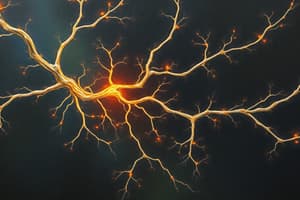Podcast
Questions and Answers
Neurons consist of four parts: dendrites, cell body, axon, and synapse.
Neurons consist of four parts: dendrites, cell body, axon, and synapse.
False (B)
Most neurons are unipolar, containing one axon and one dendrite.
Most neurons are unipolar, containing one axon and one dendrite.
False (B)
Bipolar neurons have two dendrites and one axon.
Bipolar neurons have two dendrites and one axon.
False (B)
Axons usually branch extensively at their ends.
Axons usually branch extensively at their ends.
Synapses between neurons only occur between axons and dendrites.
Synapses between neurons only occur between axons and dendrites.
Signals in neurons are propagated chemically along axons.
Signals in neurons are propagated chemically along axons.
Neurons maintain cell size and osmolarity primarily through the action of Cl- ATPase.
Neurons maintain cell size and osmolarity primarily through the action of Cl- ATPase.
The resting membrane potential (Em) is always equal to the equilibrium potential for Na+ (ENa).
The resting membrane potential (Em) is always equal to the equilibrium potential for Na+ (ENa).
Increasing the permeability of the membrane to another ion does not affect the resting membrane potential.
Increasing the permeability of the membrane to another ion does not affect the resting membrane potential.
Neurons use ligand-gated and voltage-gated ion channels to generate mechanical signals.
Neurons use ligand-gated and voltage-gated ion channels to generate mechanical signals.
The passive spread of electrical signals over short distances requires energy-dependent processes for signal amplification.
The passive spread of electrical signals over short distances requires energy-dependent processes for signal amplification.
Amplification is not required for long-distance communication down axons to nerve terminals.
Amplification is not required for long-distance communication down axons to nerve terminals.
Flashcards are hidden until you start studying




